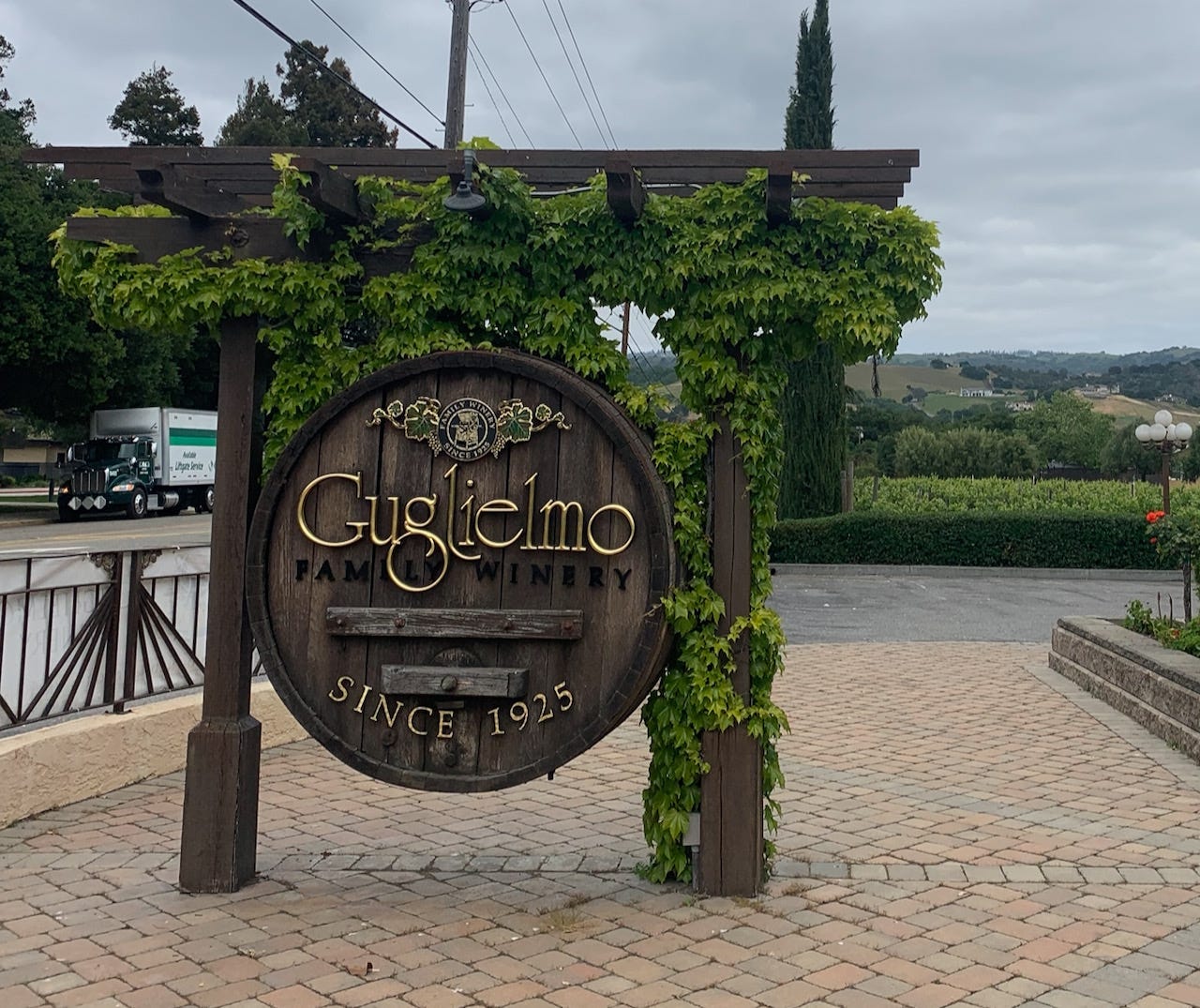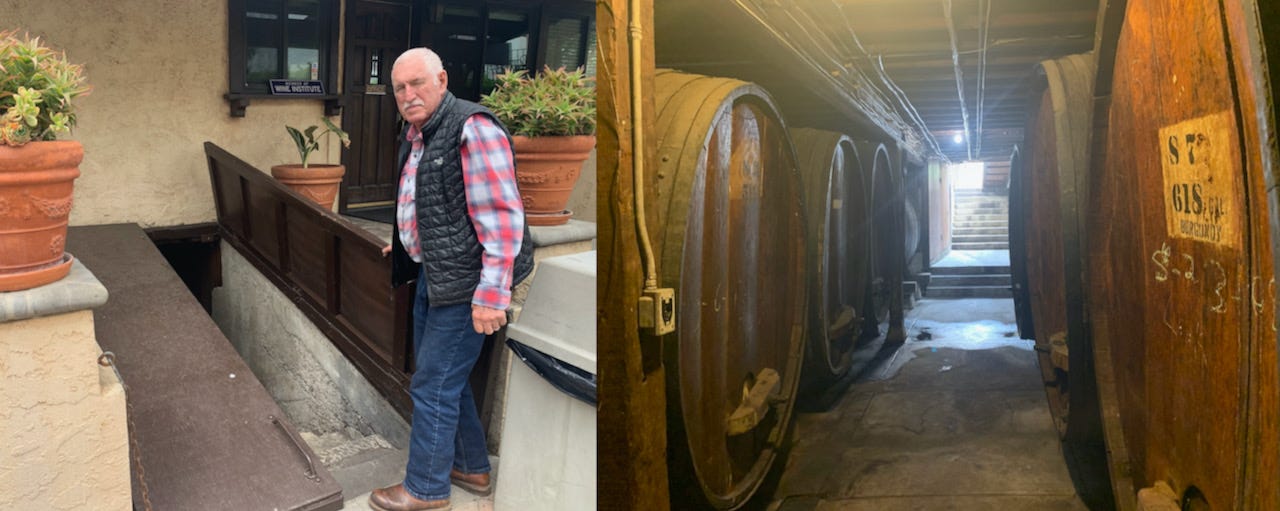A Winemaking Tradition 100 Years Strong
From Prohibition bootlegging to a century of wine at Guglielmo Winery.
Welcome to a newsletter themed at the intersection of longevity and wine history. 🍷
The Guglielmo Winery turned 100 this year, tracing its beginnings to Italian immigrants and an underground wine scene during Prohibition.
I recently met with George and Gene Guglielmo, who are third-generation winemakers. Hearing about their family-run winery in Morgan Hill felt like reimagining my great-grandfather’s Gemello Winery origin story.
Both Guglielmo and Gemello families have roots from Piedmont, the northern region of Italy. Emilio Guglielmo, the family patriarch, immigrated to San Francisco in 1909 when he was 25. Three years later, my great-grandfather (on my mom’s side), John Gemello, left Piedmont for the Santa Clara Valley.
Back in Italy, Gemello had stints making sparkling wine at Martini and Rossi as well as running his own vineyard. He also tried making ends meet donning a hard hat to work in German mines. Guglielmo also worked in mining for a while in Poland before coming to America.
They both came to California alone, made some money, then sent for their wife or wife-to-be back home. Emilio married his sweetheart Emilia in San Francisco.
In 1925, both families bought land in the Santa Clara Valley that would become home to their family-run wineries. Gemello bought 30 acres in Mountain View on El Camino Real. Guglielmo bought about 15 acres in Morgan Hill. The property has since been expanded to 80 acres.
The land purchases of the same year may be coincidental. But other similarities were perhaps not. Both families lived on the winery property and built more homes on their land when the children got old enough to have their own families.
“That’s the Piemonte way,” George said, as we sat in the winery office, which was originally the Guglielmo family home. Similarly, the original Gemello home on the Gemello Winery property was converted to winery offices in 1974. However, the one thing the Gemello house lacked was a Prohibition-era trapdoor.
Prohibition Tricks of the Trade
Emilio Guglielmo bought the Morgan Hill property on East Main Avenue from the previous owner who was making bootleg wine in a basement under the house. The trapdoor provided bedroom access to the basement, while concealing the wine operation from federal agents.
George reveals the entrance to the basement wine cellar.
Giovanni and Filippo Bargetto, brothers with roots also from Piedmont, also had a Bay Area winery that engaged in bootlegging. Bargetto Winery, now run by third-generation family members, is located southwest of Santa Clara Valley in the coastal town of Soquel. I shared their Great Prohibition Caper story last summer.
All three wineries, Gemello, Guglielmo, and Bargetto, became bonded wineries in 1933 or 1934 after the repeal of Prohibition. For wineries to last three generations is remarkable.1
To put it in perspective, there were about 600 California wineries operating by the start of Prohibition in 1920. That number dwindled to 300 by repeal. During Prohibition, California wineries produced about 20 million gallons of sacramental wine, allowed under Prohibition law. This helped some to stay afloat at least partially. While more wineries started up again after repeal, many did not survive. By 1965, the number of California wineries in operation had sunk to 225, well below the number at the time of repeal.2
There are over 4,000 wineries in California today, which may seem like a misprint, but it is not. A series of events would set off a boom over the past 25 years. Two California wines winning the 1976 Judgment of Paris tasting gave international recognition to the Golden State. A surge of boutique wineries followed in the 1980s, returning the number of wineries to pre-Prohibition levels by 1990. By 2000, California had eclipsed 1,000 wineries, then quadrupled in the next 25 years. More than half of California’s wineries are small operators, producing fewer than 1,000 cases a year.3
Guglielmo Winery produces 40,000 cases of wine annually, including petite sirah, zinfandel, merlot, cabernet sauvignon, and sagrantino, a grape indigenous to Umbria in Central Italy.
Centennial Gala May 31
Guglielmo Winery is hosting a Centennial Gala from 6 pm - 10 pm on May 31. Tickets can be purchased here.
If you’re new here—hi, I’m Kevin!
I’m the author of 🍷 Rain on the Monte Bello Ridge,🍷 my forthcoming memoir about health, aging and winemaking. (Read the origin story of the book.) 🍇
The Centenarian Playbook is my newsletter, which features:
Healthy aging/longevity tips and stories from Grandma Kay’s long life.
Wine history & stories of the Gemello Winery
Ancestry & family research tips
John Gemello’s son, Mario, sold the Gemello wine label upon his retirement to his niece, Sandy (Gemello) Obester, who ran the Obester Winery. She and her husband Paul continued to make limited quantities of Gemello wine along with the their Obester wine until they retired in 2002.
Source: Charles L. Sullivan, A Companion to California Wine: An Encyclopedia of Wine and Winemaking from the Mission Period to the Present (Berkeley: University of California Press, 1998)
Source: “U.S. Winery Count Declines Slightly,” Wine Business Monthly, 2/1/2025






Great story, Kevin. I worked at Guglielmo for over 10 years after leaving Gemello a decade before. If you are going to the Guglielmo 100th anniversary Gala I hope to meet you!